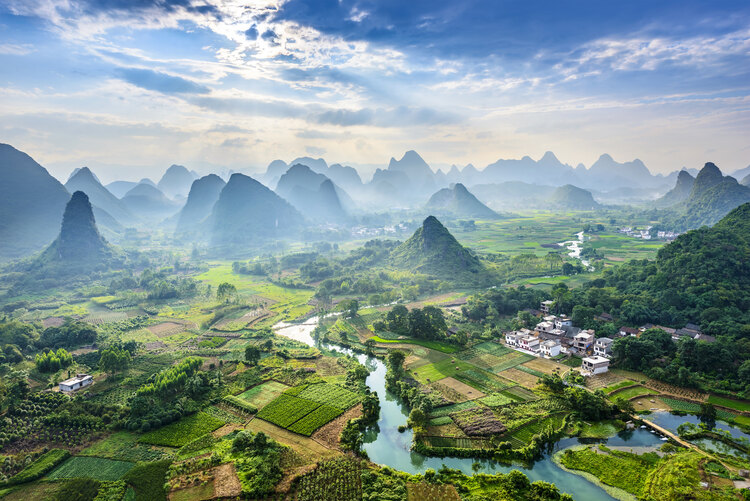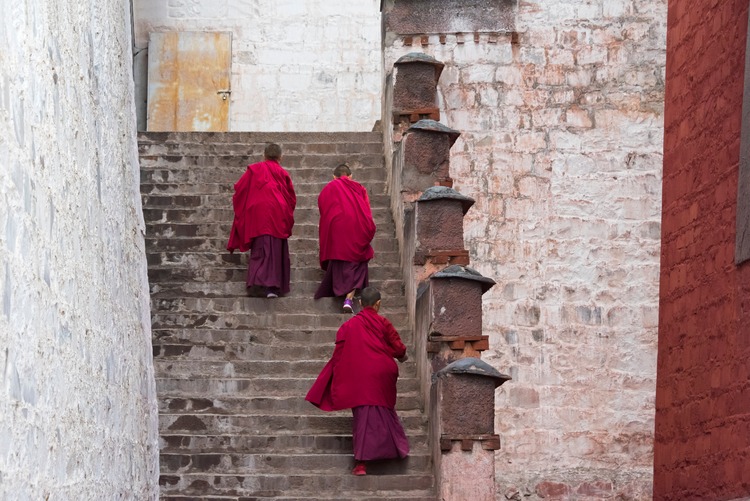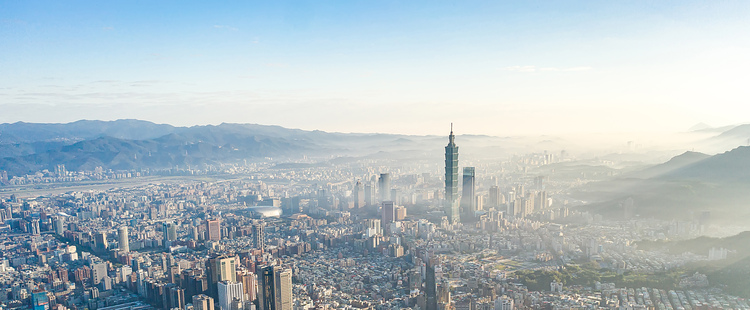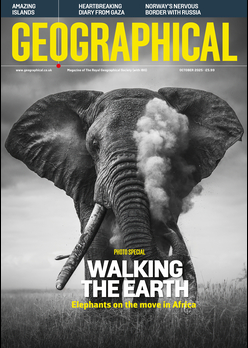
A primer to the physical and cultural diversity of the second-most populous country in the world
By Robert C Thornett
As China makes daily headlines, it is often portrayed as a monolith, represented by a handful of Chinese Communist Party elites in Beijing. But in reality, China is extraordinarily diverse, both physically and culturally. Welcome to the many Chinas.
Regions
Students in China learn that their country is roughly divided into three geographic regions. Eastern China is the lowest and wettest. 94 per cent of China’s population live in this area, east of an imaginary line known as the Heihe Tengchong Line. Often referred to as ‘China Proper’, the majority of the population are Han Chinese – the world’s largest ethnic group which accounts for 92 per cent of China’s population as a whole. Eastern China is largely made up of green coastal plains, with enormous farms and ports connecting China to the world.
Moving from east to west, China generally gets higher and drier. The second region, Central China, is a mix of mountains and green valleys. It includes the Sichuan Basin, a cultural sphere that is distinguished by its own unique customs, cuisine and dialects. It is famous as the home of the panda and for its extensive rice cultivation. Today, it is also a vast industrial base.

The third region is Western China, the highest and driest. It includes some of the world’s highest mountains within the Himalaya, as well as Tibet (annexed in 1951), the world’s highest and largest plateau. Western China is home to Islamic and Buddhist communities as well as nomadic groups, maintaining strong cultural ties to the other countries of Central Asia.
The relative economic importance of China’s three regions has flipped over the course of the last 1,500 years. During China’s Tang (618 to 907CE) and Song dynasties (960–1279), its economy centred on the Silk Road in the west, which stretched from Chang’an (now Xi’an) across Central Asia to places such as Tehran and Baghdad in the Middle East and all the way to Europe. As the Silk Road declined, China began to increase trade in the east with Japan, Korea, the Philippines, and later European powers and the eastern coast gained importance.
Today, the government in Beijing is working to modernise many long-neglected regions of Western China and revive the old Silk Road trading routes via its Belt and Road Initiative (also called the New Silk Road) — a vast infrastructure project that aims to span the globe.
Language and minority groups
Mandarin Chinese became China’s official language in 1911, but in 2010, China’s Education Ministry admitted that 400 million people, or 30 per cent of China, do not speak Mandarin. Instead they speak one of approximately 300 languages and dialects spoken in the country. These include regional dialects of Chinese, such as Hakka and Yue in southern China, Jin around Shanxi, and Wu spoken around Shanghai and Zhejiang. There are also many non-Chinese languages spoken by China’s minority groups. For example, in mountainous Yunnan province (which borders Vietnam, Laos, and Myanmar), there are 25 minority tribes who each speak their own language, such as the Bai, Hani, Dai, and Lisu.
China’s ethnic minorities are situated largely within the country’s borderlands. The western borderlands are home to 13 million Uyghurs and 6 million Tibetans. The northern borderlands are home to 6 million Mongolians. The eastern borderlands are home to 2.5 million Koreans. In total, the country recognises 56 ethnic groups, and five of these are so big that the government has given them their own autonomous regions. Two are Islamic: Xinjiang and Ningxia, and three are Buddhist: Tibet, Inner Mongolia, and Guangxi. (Guangxi is the home of the Zhuang people, who practice a religion called Mo. They are the largest ethnic minority in China.)

One of these autonomous regions, the Xinjiang Autonomous Region, is China’s largest provincial-level territory by area. Xinjiang is the home of the Islamic Uyghurs. China has been accused of interning millions of Uyghurs in prison camps and subjecting them to inhumane treatment.
As such a large territory, it is inevitable that China’s borders are liminal zones, where cultures mix. In the cold north where China meets Russia, the quirky border city of Suifenhe accepts Russian rubles as official currency and receives busloads of Russian tourists and shoppers on weekends. A few hours away, the provincial capital, Harbin was once home to more than 40,000 Russians during the 1910s. Today, Harbin has many beautiful Russian churches and lots of Russian restaurants and bakeries. Many Chinese people in Harbin speak Russian and many have mixed Russian-Chinese ancestry.

Economic inequality
If China varies physically and culturally, the same can be said for the prosperity of its different regions. Rural China tends to be much poorer than urban China and hundreds of millions of internal migrants move to the cities. However, this process is not always easy. China’s infamous hukou system – the system of household registration – means most Chinese citizens are automatically registered as a resident of the place where they were born and typically only get government benefits, such as free education and health care, if they stay put. This makes it very costly to migrate inside China and potentially contributes to migration out of the country. Changing hukou is possible, but it is expensive and takes many years. Some commentators have likened the hukou system to a caste system. Even China’s president, Xi Xinping, wrote his doctoral dissertation back in 2001 on the need to reform the hukou system. In August 2023, the province of Zhejiang and China’s central government announced significant changes to the hukou system. However, while some positive changes are taking place, there remains little indication that Beijing is serious about undertaking wholesale changes to the system.
Inequality also persists across China’s coastal and interior regions. China’s long coast on the Pacific Ocean is where most of its biggest cities, ports, and manufacturing industries are located. The coast is also where China is most globalised and where it has had the most contact with foreign countries. Development in China’s interior provinces has generally been neglected and lags far behind.
The exception, however, is along the Yangtze River, the longest river in China, which penetrates deep into the interior. The Yangtze River Basin is the third-largest economy in the world. Around 175 cities lie near the Yangtze’s banks, including three exploding megacities, Chongqing, Wuhan, and Shanghai, and a soon-to-be fourth megacity of Nanjing.

Provinces
Mainland China is made up of 23 provinces and four centrally-controlled divisions. Huge variations in culture and wealth exist across them. While some provinces are vastly economically productive, such as Jiangsu on the east coast, which has a GDP on par with Singapore and Sweden, others are struggling. Guizhou, located in a mountainous region of southwest China, recently admitted defeat in trying to sort out its finances and is appealing to Beijing for help to avert default.
Each province has its cultural claim to fame. While Szechuan province is famous for its laid-back tea houses, spicy food, giant pandas and Szechuan opera, Hunan province is where many of China’s most popular TV quiz shows and reality shows are made. Guangdong province has more factory jobs than the entire United States and is known for Cantonese cuisine such dim sum as well its approach to eating ‘everything on the table’, from chicken feet to the smelly tropical durian fruit.
China’s provincial governments compete against each other intensely when it comes to GDP rankings, attracting foreign investment, lowering carbon emissions, and green innovation, hoping for rewards from the central government in Beijing. Because each provincial government has close ties to local state-owned enterprises they often act like competing businesses.
Hong Kong and Macau
Former European colonies Hong Kong and Macau are today classified as China’s only two Special Autonomous Regions or SARs. Hong Kong was a wealthy British colony until 1997, while Macau was a Portuguese colony until 1999. They have long operated under their own legal systems, which are very different from the rest of China, although in recent years the CCP in Beijing has implemented measures to close the gap.
The importance of both regions belies their small size. Hong Kong is an international financial hub, and Macau is a global gambling hotspot. They have the top two GDPs in all of China, as well as their own currencies: the Hong Kong Dollar and Macanese Pataca. Hong Kong’s official languages are Cantonese, English, and Mandarin, and Macau’s are Portuguese and Mandarin. For more than 150 years, these two unusual territories have been gateways to China for the rest of the world.

Taiwan
Taiwan, officially known as the Republic of China (ROC), is an island off the coast of China. It is populated by ethnically Chinese people who speak dialects of Chinese. It was founded by members of China’s Nationalist Party who, on losing the Chinese Civil War to the Communists in 1949, fled to Taiwan and founded a new alternative China, the Republic of China or ROC.
Today, Taiwan is an independent democratic country and is one of the world’s most successful economies. A single Taiwanese company, Taiwan Semiconductor Manufacturing Company (TSMC), produces 92 per cent of the world’s advanced microchips, making even the US and China dependent on Taiwan.

Today, Beijing insists that there is only ‘one China’, and that Taiwan is a part of it. It has vowed to ‘unify’ Taiwan with the mainland. Taiwanese present Tsai Ing-wen favours independence and the situation is increasingly tense. Some analysts fear that if China were to attack Taiwan it could draw the United States into a war with China.
Whatever the rhetoric from Beijing may be, the idea of ‘one’ China has always been impossible to realise. With 1.4 billion people, and a wealth of different religions and cultures, there will always be many Chinas.




